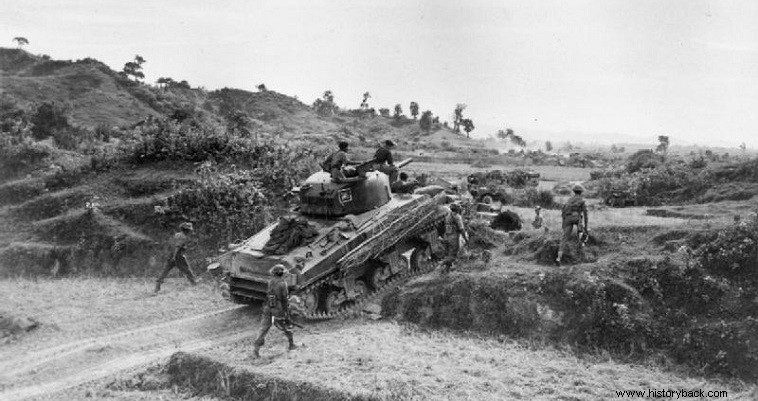
In 1945 the Allies were pressing the Japanese in Burma. The British administration decided to occupy the Arakan region trying to cut off the retreat of the Japanese towards Rangoon. For this purpose, it was decided to land the 3rd Commando Brigade in the rear of the enemy.
In late December 1944 the XV Indian Army Corps launched the offensive. Corps command reserved an important role for the 3rd Commando Brigade (1st, 5th, 42nd and 44th Commandos under Brigadier General Campbell Hardy). The plan provided for the landing first of the 5th Commando which would act as a vanguard and then of the other divisions with the aim of capturing Kangau and important strongholds around it to cut off the Japanese retreat route.
The 5th Commando of the 3rd Commando Brigade landed at Maybon on 12 January. The commandos moved through swamps and rice paddies carrying all their equipment. The main salient in the area was Hill 170. At the same time the other units of the 3rd Brigade landed 3 km south of Kangau without any preparatory fire so as not to be noticed by the Japanese.
1st Commando was ordered to secure Hill 170 with support from 5th Commando. The 42nd Commando would secure the bridgehead while the 44th Commando was tasked with securing two small valleys east of Hill 170. All this was done without the Japanese reacting.
It wasn't until the night of January 23-24 that the first Japanese reaction occurred with an attack in one of the valleys that the British had named Pinner. The Japanese artillery began to pound the British but they endured exemplary. On 26 January conventional units replaced the 44th Commando in the two valleys.
British forces managed to capture Kangau but the Japanese counter-attacked. On 31 January the Japanese 154th Infantry Regiment, supported by artillery, attacked the British positions on Hill 170. The Japanese focused their attack on the 1st Commando positions on a front only 100m in waves.
The commandos were supported by three Sherman tanks, two of which were immediately destroyed by Japanese infantry suicide squads. At the same time, they suffocated the 4th Ulama of the 1st Commando who was guarding the front at this point. An attempt by the British to fight back was repulsed by massive Japanese machine gun fire. Another counterattack supported by the single Sherman also failed.
Even so, the Japanese were unable to overturn the British as the 42nd and 5th Commandos rushed to support the 1st Commando, while an Indian battalion outflanked the opponents. However, the stubborn Japanese continued and launched a night attack against the 5th Commando, which was repulsed after a fierce hand-to-hand fight with bayonets and knives.
After this the Japanese retreated admitting their defeat. The British discovered the bodies of 340 Japanese. They had 45 dead and 90 wounded. New British landings in Arakan resulted in all Japanese 28th Army forces being ordered to withdraw from the area.
Lieutenant George Nowland, head of the 4th Ulam of the 1st Commando, was declared the hero of the battle. He and his 24 men literally fought heroically . He himself was killed and 14 of his men were killed or wounded.
